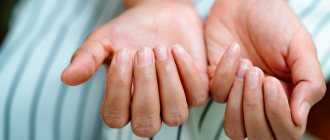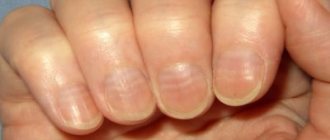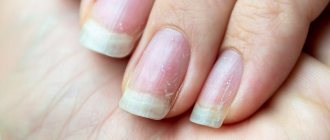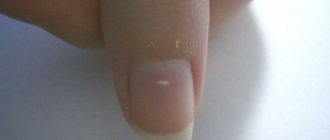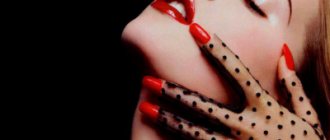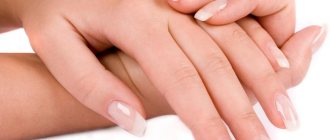Sometimes the nails on the hands and feet turn blue and this can be caused by various factors. Some diseases can be determined by the condition of the nails. We will try to analyze the common causes of blue nails, and most importantly, when to see a doctor.
The condition of your nails is a very important factor in determining your overall health. This is why some doctors examine nails during the initial examination.
Healthy nails have a uniform pink tint, but with some diseases their color changes. For example, blue nails may be an indicator of low hemoglobin levels and, accordingly, a lack of oxygen in the blood.
When you have bluish or purple skin under your fingernails or around your eyes, lips and gums, you may be experiencing a condition known as cyanosis. It occurs when the number of red blood cells (hemoglobin) is low. This condition is also known as hypoxemia.
Why do my nails turn blue?
Blue nails can be a warning sign. Low oxygen levels cause the skin, lips, fingertips and nails to turn blue or purple.
This phenomenon also occurs if you are exposed to very low temperatures. Then this is a temporary problem, because when you warm up, the blood circulation will resume. Bluish lips and fingertips will turn pink again.
Severe problems with darkened fingertips may indicate the presence of a condition such as Raynaud's disease. With this disease, blood circulation in the fingers and toes is very slow, which leads to a change in the color of the skin and nails.
Additionally, Raynaud's disease causes extremely cold sensation in peripheral areas. If you have this disease, your fingers, toes, nose, lips and earlobes become very painful when exposed to cold air.
In the early stages, Raynaud's disease may not be a cause for concern. A correct diagnosis at a consultation with a doctor will allow you to adjust your lifestyle so that the disease does not progress further, for example, playing sports, contrast showers and warm clothes.
Another disease that can cause blue nails is melanoma. This is a very serious form of skin cancer that causes abnormal development of melanocytes (pigment cells).
This form of cancer usually appears as a dark, flat, irregular mole, but it can also grow under the nail. Fortunately, this manifestation of melanoma is quite rare.
The most basic reason why nails turn blue is blood circulation problems, especially in the following cases:
- Chronic obstructive pulmonary disease (COPD);
- Pulmonary embolism;
- Chronical bronchitis;
- Heart problems;
- Emphysema;
- Suffocation;
- Exposure to high altitudes.
Poor blood circulation can be a reaction to certain medications.
Among them:
- Benzodiazepines;
- Minocycline;
- Drugs;
- Sedatives.
If you take colloidal silver as a dietary supplement, a sometimes irreversible condition known as argyria may occur as an adverse reaction. In this case, the skin over the "crescent" at the top of the nails will appear bluish or slightly bruised.
If your nails turn blue due to a low amount of hemoglobin, then you may experience some other symptoms, such as shortness of breath, fatigue and drowsiness. When your blood doesn't have enough oxygen, it affects your energy levels.
Types and symptoms
The classification of nail melanoma provides for two variants of the course of the disease: horizontal and vertical stages. Symptoms of the disease will depend on what type we are talking about.
In the horizontal stage, the patient observes a brown or black stripe on the nail (under the plate). The strip is not necessarily uniform; it can expand, capture more of the free nail edge, and transfer to the skin.
During the vertical stage, the tumor begins to grow into the surrounding tissues, deformation of the nail occurs, and it becomes fragile. As the tumor grows, the nail cracks, the surface becomes covered with bumps, and at the slightest mechanical impact it begins to bleed. The pigment in this case can also be either brown or black.
It is important to understand that nail melanoma can be non-pigmented until a serious stage. For this reason, until the tumor begins to spread vertically, it may not be noticed. This is typical for approximately 30% of cases.
Not always, but the disease can also manifest itself with the following symptoms:
- burning, itching in the area of the tumor;
- feeling of fullness;
- pain that increases as the tumor develops;
- decreased functionality of the limb.
Common symptoms on the toenail or fingernail include fever, weakness, and severe weight loss. With the development of metastases, local symptoms are added - those that are characteristic of diseases of the affected organs.
Are you experiencing symptoms of nail melanoma?
Only a doctor can accurately diagnose the disease. Don't delay your consultation - call
Prevention measures
To prevent the appearance of a blue tint on the nail plate, it is recommended to pay daily attention to caring for it and preventing aggressive exposure to external factors.
All rules prescribed by doctors are based on the reasons why darkening may reappear, so they are also prescribed for the entire period of treatment.
There are several recommendations for prevention:
- Do your manicure properly. To process nails, it is recommended to use a file instead of sterile nail scissors, moving it in one direction. The cuticle must first be pushed back with a pusher and then cut off with nippers. The free edge should not be cut close to the skin;
- Maintain personal hygiene, change your socks once a day;
- Wear spacious, comfortable shoes in which the toes do not rest against each other, but are in a natural state;
- Always wear personal footwear, even in saunas or water parks, to prevent fungal infections;
- When using chemical compounds, protect the surface of your hands with thick rubber gloves to prevent exposure to aggressive components;
- If there is mechanical damage to your fingers or hands, begin treatment immediately to prevent complications;
- In winter, do not neglect to wear warm gloves, mittens, and socks to prevent hypothermia of the sensitive area, which can lead to frostbite.
Also keep in mind that hands and feet should always be dry, since a humid environment promotes the growth of pathogenic bacteria, which quickly spread to the girl’s fingers.
And if you are getting a manicure in a salon, first make sure that sterile consumables and products are used, and that the master properly processes the free edge of the nail.
Other causes of blue nails
If you don't have any bad symptoms, the problem could most likely be caused by something as simple as bruising. You can damage your nail without even realizing it.
If only one or two nails show blueness, then it is a simple bruise. The bruise under the nail plate should simply heal, although this will take quite a lot of time.
Some types of fungal infection can cause blue nails. If you feel itching or develop a rash, especially on your legs, then you probably have a fungal infection.
Diagnostics
Diagnosing melanoma under the nail is not so easy, because it is often similar to other diseases or problems, for example, subungual hematomas. To exclude simpler situations and make an accurate diagnosis, doctors use dermatoscopy (examination of tissue under high magnification), as well as epiluminescence microscopy. The latter method involves examining changed areas of tissue in a special environment. Thanks to it, it is possible to distinguish a benign disease from a malignant one.
Cytological studies are carried out, but a biopsy in this case is undesirable, since it can provoke the development of metastases. Additional tissue examination is carried out after surgery, when the tissues are removed.
If nail melanoma is not excluded after examination, marginal resection of the nail is performed followed by tissue examination. When the diagnosis is confirmed, the patient is indicated for radical surgery.
Additionally, the following research methods are used:
- Ultrasound;
- CT;
- MRI.
They are needed to verify the presence or absence of metastases.
How to treat blue nails?
Now we know that nails turn blue for various reasons. This could be an injury, a bruise, or even dangerous diseases and conditions of the body.
To keep your nails beautiful, you need to lead a healthy lifestyle, which will benefit your entire body. Here are some simple habits.
Avoid injury and infection
Always keep scissors and other nail care tools clean. Never use other people's tools; they should be personal, just like a toothbrush.
Sharing uncleaned nail scissors can cause fungal or bacterial nail infections.
Make sure your toes and nails are trimmed promptly to prevent them from peeling or breaking. This also leads to infection. Wash your feet regularly.
Avoid injury to your nails by wearing work gloves when performing potentially hazardous work.
Nails always turn blue when there is a bruise. Some people try to pick out the collected blood under the nail with sharp objects. This cannot be done, as this opens the way for bacteria to enter the wound.
It’s better to let the nail grow at its own pace, then the bruise will go away. The only thing you can do in this case is to soak your fingers in cold water with ice, which will relieve some of the pain.
Increase hemoglobin
Eat right and don't go on crash diets. You may lose weight quickly, but your body will not receive any benefit.
Since hemoglobin is mainly made up of iron, be sure to include iron in your diet, which will help increase your hemoglobin levels.
Foods containing large amounts of iron include:
- Red meat;
- Almond;
- Oysters;
- Spinach;
- Lentils;
- Shrimps;
- Tofu;
- Liver.
Be sure to eat plenty of fresh fruits and vegetables to get your daily vitamin C intake: citrus fruits, berries, and dark green leafy vegetables. Ideally, your diet should consist of about 50% fresh fruits and vegetables.
Folic acid is also important for the production of hemoglobin. Foods high in folic acid include organ meats, bananas and peanuts.
If you are having trouble watching your diet, take a high-quality multivitamin with iron and vitamin C (500 to 1,000 mg per day) to help your body absorb iron better.
Vitamin supplements should also contain copper, as it is necessary for the absorption of iron.
Remember not to overdo your iron supplementation. The amount of the vitamin in a standard multivitamin supplement is sufficient, although you can continue to eat all foods rich in natural iron.
Iron from dietary supplements in large quantities has a negative effect on the liver, which cannot be said about natural iron from food.
The best way is to take a multivitamin with a small amount of iron in combination with foods high in iron.
Beware of problems with the circulatory system
We have already said that nails turn blue due to poor blood circulation. Eating a healthy diet significantly improves the efficiency of the circulatory system.
In addition to the healthy foods recommended above, you should also consume whole grains and low-fat dairy products.
In addition to proper nutrition, moderate physical activity also stimulates blood circulation. If you have time, then aerobic training two to three times a week will do, and if you don’t have enough time, then just do any physical activity for at least 30 minutes every day.
Walking, biking, swimming, dancing, exercising, or participating in any active activity you enjoy is a great way to improve your circulation, lift your mood, and reap many health benefits.
Even if you don’t have time for a full workout, be sure to get up and, in the intervals of free time, walk quickly or actively do cleaning and other household chores.
Watch your weight
Maintaining a healthy weight is very important for your health. Being excessively thin is just as harmful as being excessively fat.
If you are undernourished, you will quickly develop anemia due to a lack of hemoglobin in the blood, which is why your nails turn blue, among other problems.
Being overweight increases your chances of heart disease, high cholesterol, arteriosclerosis, high blood pressure, diabetes, and more. All of this causes or worsens poor circulation.
Develop healthy habits
Make sure your meals consist of about 50% fresh produce, 25% whole grains and 25% high-quality protein sources.
Drink plenty of clean filtered water . Good hydration is the foundation of health.
Fresh, clean water ensures the smooth functioning of all organs of the body. It flushes out toxins, helps blood circulate freely, improves the condition of joints, muscles, skin, hair, nails and any other part of the body.
Don't eat processed foods. As a rule, if food is in a box or can, it is not very healthy. Better eat fresh foods.
Don't drink soft drinks. Unfortunately, in today's society, many people turn to carbonated soft drinks filled with sugar, chemicals, artificial colors, flavors and caffeine when thirsty.
They are not useful, do not eliminate thirst, but only further enrich the body with toxins.
Limit your alcohol intake. Although some health experts claim that drinking alcohol in small doses is good for the body, only negative results are evident so far.
Alcohol contains a lot of sugar, which means extra calories, which is very harmful for people struggling with hypertension and diabetes.
Do not smoke. Nicotine, pesticides and other chemicals found in tobacco are extremely hazardous to health. Cigarettes dramatically increase the risk of cardiovascular disease. As we already know, poor blood circulation or low hemoglobin are the main causes of blue nails.
What to do if your nail turns blue
If a patient’s nails are blue due to something other than simple pinching of the arms or legs, then you should see a doctor. He will assess the patient’s condition and prescribe treatment. If the blueness of the fingernails is associated with injury, congestion or chemical exposure, you can simply apply ice to the hematoma or bruise. This will reduce the pain and make the patient feel much better. If the blue color on the nails is caused by incompletely removed varnish (corrosive pigment), then you can restore the shade of the plate using the following methods:
- Salt baths - add a tablespoon of sea salt to a glass of water; if desired, you can add baking soda on the tip of a knife. Immerse your nails in the bath for 10-15 minutes, repeat if necessary.
- Cut a slice of lemon, immerse the slices in its juice, leave for 5 minutes, and rinse off the residue with water. Repeat until the blue discoloration is eliminated.
Hand massage will help to cope with the blue color of the plates, it improves the functioning of blood vessels and stimulates healthy nail growth. Blue feet are often the reason for wearing tight, uncomfortable shoes . You can change it to the appropriate size to get rid of the problem and normalize the functioning of blood microflow in the extremities. You can eliminate other causes of blue color using the following methods:
- temporarily stop using varnishes and nail polish removers;
- replenish the supply of vitamins and minerals in the body (start taking nutrient complexes) to strengthen the immune system;
- prevent the effects of cold temperatures (do not wash your hands in cold water, do not go outside in winter without gloves or mittens).
If the blue color or cyanosis of the nails is caused by heart failure, you need to take a course of medications that support heart function. When the bruise is caused by a hematoma and it does not go away on its own, the doctor may prescribe nail removal or tissue puncture:
- A local anesthetic (Lidocaine, Novocaine) will be administered. The plate will be removed to examine the nail bed. The area underneath is cleaned, if tissue is damaged, it is washed, and if necessary, sutured.
- If the patient does not want to remove the blue nails, the doctor can pierce them with a sterile needle to remove the liquid. Then the hole is burned out with a special device, and a tight bandage is applied to the wound treated with an antiseptic. To speed up healing, it is recommended to take warm baths with Epsom salts twice a day for 10-15 minutes. Afterwards, an antibiotic ointment is applied to the plate, and a dry sterile bandage is applied. Recovery will take 2-3 weeks; if the entire nail is removed, it will take up to three months.
If the cause of cyanosis is a fungus, then you should undergo antifungal treatment. It includes daily steaming of nails in a warm soap or salt bath, scraping off dead cells and applying antimycotic agents (drops, sprays, thick ointments or solutions, under an occlusive dressing).
In case of frostbite, you should immediately consult a doctor for help so that the damaged tissue does not die and the condition does not lead to purulent infection and sepsis. In the first stages of frostbite, restorative therapy and treatment of the skin and nail plate with antibiotics are indicated . In advanced cases, it is possible to remove the nail to prevent the development of gangrene and blood poisoning.
Call your doctor or nurse if you have:
- temperature rises to 100.4°F (38°C) or higher;
- chills.
- worsening of any symptoms;
- have any of the following symptoms around or under the nail: hot, hard, or painful skin;
- bright yellow or green discharge;
- bleeding;
- unpleasant odor;
- increasing redness or swelling;
- increasing pain or discomfort;
- redness;
to come back to the beginning
When to see a doctor?
In the absence of serious symptoms, especially if the nails turn blue due to bruises and contusions, then this is not a problem. But if blue nails persist for a long period of time or you suffer from pain and other unpleasant symptoms such as shortness of breath, then consult a doctor immediately.
To determine the cause of blue nails, your doctor should conduct a complete physical examination.
Blue nails can be a symptom of a serious illness. If the condition is severe, you may have trouble breathing, fatigue, or other signs of illness.
Remember that cyanosis occurs when there is low oxygen supply to the tissues, which is caused by poor circulation.
Although blue nails can be a warning sign of serious health problems, this is not always the case. Sometimes accidents and nail infections can be avoided through proper hygiene and safe habits during hard work.
Cosmetical tools
Blue fingernails may be a consequence of using low-quality cosmetics. If they are used frequently, the health of the nail plate can deteriorate significantly. It may not only acquire a blue or yellow tint, but also begin to crumble or delaminate. To avoid this, it is necessary to use natural remedies. But if damage to the nails has already occurred, you must first stop using chemicals and carry out medical procedures. To do this, you can use masks and baths made from natural cosmetics. You also need to start using special vitamin and mineral complexes that are aimed at strengthening your nails. It is advisable to quit bad habits and change your diet.
Dark streaks due to disruption of the digestive system
Stripes on nails may reflect dietary habits
Oddly enough, eating undercooked pork often provokes dark streaks. In this case, it is recommended to consult a nutritionist and replace certain types of meat with fish, eggs, dairy products and seafood.
Fruits are recommended, especially green apples, as well as vegetable salads.
In addition, such phenomena often occur with gastritis or ulcers of the stomach and/or duodenum, as well as with gastroduodenitis and ulcerative colitis.
